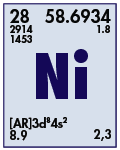What are the Differences Between Various Nickel-based Metals and Alloys?
This file type includes high-resolution graphics and schematics when applicable.
Nickel is a versatile metal element that alloys with most other metals. It gives alloys great corrosion resistance and the ability to withstand high temperatures and pressures. Here’s a quick look at five of the more common nickel alloys.
Extra-high nickel alloys (Duranickel): These all have more than 94% nickel content. Extra-high nickel alloys that have 4.75% manganese resist sulfidation at high temperatures. Duranickel 301 becomes much stronger if thermally treated, which causes precipitation of submicroscopic particles of Ni3Al and Ti throughout its matrix, a process called precipitation hardening. Duranickel retains excellent spring properties up to 600°F. The corrosion resistance of these alloys is similar to that of commercially pure wrought nickel.
Nickel-molybdenum (Ni-Mo), nickel-molybdenum-chromium (Ni-Mo-Cr) alloys (Hastelloys): Alloys in this category are used for their high strength despite high temperatures and corrosive surroundings. Hastelloy B is known for its resistance to HCl (hydrogen chloride) and for its creep and rupture strength at temperatures around 1,400°F.
Hastelloy C resists active oxidizing agents such as wet CL2 (chlorine), hypochlorite bleach, FeCl3 (iron chloride), and HNO3 (nitric acid). Hastelloy C also resists oxidizing and reducing atmospheres at temperatures up to 2,000°F, and can still carry loads at temperatures to 1,600°F.
Hastelloy C-276 resists pitting, stress corrosion, cracking, and reducing atmospheres as hot at 1,900°F. It also resists formation of grain-boundary precipitates in heat-affected weld zones, so it is suitable for most chemical-process applications in the as-welded condition.
Nickel-molybdenum-chromium-copper (Ni-Mo-Cr-CU) alloys (Illium): Engineers often turn to these alloys, which are mostly cast, for their corrosion resistance. Wrought Illium, for example, is highly resistant to sea water, H2SO4 (sulfuric acid), HNO3 (nitric acid), and H3PO4, (phosphoric acid), as well as many fluorides. Wrought Illium’s cast counterpart is Illium G.
Illium B, a cast alloy, is especially resistant to sulfuric acid. It can also have its hardness increased by heat treatment at temperatures from 1,100°F to 1,400°F.
Illium 98 is a casting alloy with much better corrosion resistance than Illium G. Several of these Illium alloys also highly resist wear and abrasion in corrosive environments.
Illium G, a weldable wrought alloy, resists hot sulfuric acid and phosphoric acid.
Nickel-copper alloys (Monel): The most common of these alloys are Monel 400, Monel R-405 (a free-machining alloy), and Monel K-500. The K-500 version can be precipitate-hardened to high levels of strength much like Duranickel.
These Monel alloys combine ready formability, a wide range of mechanical properties, and high corrosion resistance. They are strong and tough at sub-zero temperatures and are generally free from stress-corrosion cracking. K-500, however, shows a tendency to stress-corrosion cracking when it is precipitation-hardened.
Cast nickel-copper alloys containing 3 to 4% silicon have excellent nongalling and anti-seizing characteristics.
Nickel-chromium (Ni-Cr) and nickel-chromium-iron (Ni-Cr-Fe) superalloys: These alloys, which include Inconel 600 and Inconel 800, are noted for their strength and corrosion resistance at high temperatures. Some of these alloys are derived from the Ni-Cr group by adding aluminum and/or titanium for precipitation hardening. Controlled precipitation hardening of Ni-Cr and Ni-Cr-Fe alloys lets metallurgists increase strength and hardness temperatures to about 1,300°F. Included in this list of precipitation-hardened alloys are 713 C, IN-100, IN-733, MAR-M200, MAM-241, Mar-M432, and wrought alloys Inconel X-750, Rene 41, Rene 95, Waspaloy, Udimet 700, Astroloy, and Udimet 520.
Several of these types of alloys (Inconel 625, IN-102, Udimet620, and RA 383) can be strengthened by adding refractory metals such as molybdenum, tungsten, and columbium. The resulting alloys have good oxidation resistance and strength at high temperatures. They cannot be precipitation- hardened, but they can withstand thousands of hours at temperatures to 1,200°F. Alloys HW and HX (Alloy Casting Institute designations) are typical casting alloys that survive temperatures to 2,000°F.




